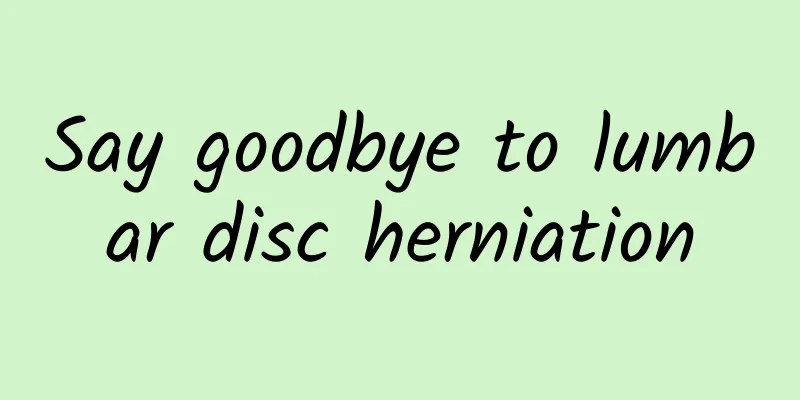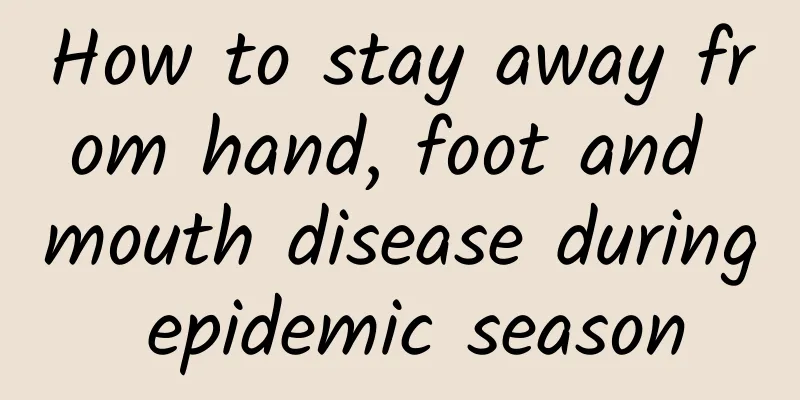Say goodbye to lumbar disc herniation

|
1. Soldiers are a high-risk group for lumbar disc herniation Seeing the above pictures, I believe everyone is familiar with them. Long-term driving, high-intensity training, long-term sitting and harsh environment are all common causes of lumbar disc herniation in this special group of soldiers. Lumbar disc herniation has also become a "star" disease in the military. In addition to the special group of soldiers, have the elders in your family also suffered from low back pain when lumbar disc herniation occurs? What is the mechanism of lumbar disc herniation? 2. Anatomical basis of lumbar disc herniation After the various parts of the lumbar intervertebral disc (nucleus pulposus, annulus fibrosus and cartilage plate), especially the nucleus pulposus, have undergone varying degrees of degenerative changes, the annulus fibrosus of the intervertebral disc will rupture under the influence of external factors, and the nucleus pulposus tissue will protrude (or fall out) from the rupture to the back or inside the spinal canal, causing stimulation and compression of the adjacent spinal nerves, resulting in a series of clinical symptoms such as low back pain, numbness and pain in one or both lower limbs (the incidence rate is highest in L4-5 and L5-S1, accounting for 95%). 3. Characteristics of people who are "favored" by lumbar disc herniation Now that we know what lumbar disc herniation is, how can our dear comrades avoid being "favored" by it? Here is a list of its fears, come and have a look! Poor posture, such as sitting incorrectly, hunching over; Sudden trauma, commonly known as "slipped waist"; Occupational factors, such as soldiers, weightlifters, drivers, and porters. 4. Common clinical manifestations of lumbar disc herniation Low back and leg pain, limited waist movement; Radiating pain in the lower limbs and decreased motor function; Bowel and bladder problems; Abnormal sensations Specific body positions for lumbar scoliosis (because postures for lumbar scoliosis can reduce pain); Paravertebral tenderness and percussion pain. 5. Treatment of lumbar disc herniation 1. Non-surgical treatment 1. Physical therapy: Tuina, massage; traction therapy; physical therapy (local hot compress). 2. Drug treatment: Chinese medicine, treat the symptoms; Western medicine, anti-inflammatory, analgesic and anti-rheumatic. 3. Magnetic therapy 4. Rehabilitation training for lumbar disc herniation (1) Swallow Movement Lie prone, put your hands behind your back, straighten your knees, and lift your head and legs as high as possible. Hold for five seconds, then relax. Repeat 15 times as a set, 2 times a day, 3 sets each time. (2) Stand up with your legs folded Lie flat on your back with your legs together. Hold your thighs with your hands and slowly lift them up, bringing your knees as close to your chest as possible. Repeat 10 times to relax your waist. (3) McKenzie training, practicing prone position 5. Absolute bed rest 6. Traction therapy 2. Surgical treatment 6. Misunderstandings about Lumbar Disc Herniation However, people often have certain misunderstandings about lumbar disc herniation, which leads to worsening of the disease and unsatisfactory treatment results. Come and see if you have fallen into any of these misunderstandings? Think it is not a disease Think it can't be cured Trusting folk remedies can delay the onset of illness Lack of knowledge about surgery, believing that paralysis will occur after surgery Superstitious about the results of imaging examinations (imaging examinations must be supplemented with symptoms and signs to confirm the diagnosis) Lumbar disc herniation is not equal to lumbar disc herniation (lumbar disc herniation is often a diagnosis made in imaging studies, while lumbar disc herniation must have symptoms of nerve damage) 7. Prevention of Lumbar Disc Herniation Go to the hospital promptly if you experience symptoms of low back pain. Sleeping on a hard bed appropriately can help the spine maintain its natural physiological curvature, keep the waist muscles at rest, and keep the lumbar spine relaxed and free of burden. Keep your waist and legs from getting cold: Develop good eating and living habits, protect your waist and legs from getting cold, and take care of yourself and don't overwork yourself. Squatting to pick up heavy objects: You should first squat to pick up the heavy object, then stand up slowly, trying not to bend over. Stand like a pine tree and sit like a bell: Neither sit for too long nor stand for too long, stand or sit upright with your chest up and your waist straight. Change your postures: The same posture should not be maintained for too long. Do appropriate in-place activities or waist and back exercises to relieve muscle fatigue. Appropriately increase physical exercise, such as Tai Chi, walking, swimming, etc. are all good choices! Comrades, take action quickly and say goodbye to intervertebral disc herniation! |
Recommend
Standard value of placental thickness at 12 weeks
We all know that paying attention to the state of...
What happens if the menstrual flow is light during the period?
During the menstrual period, the amount of menstr...
Can I do my hair when my period comes?
Women all love beauty, especially young women now...
Autumn is the peak season for bone diseases. Have you received the signal? You must read this maintenance manual!
1. What bone diseases should be prevented in autu...
Why can't the Apple tablet be charged? What should I do if I forget the unlock password of the Apple tablet?
You probably often encounter this problem. When y...
Can a 21-year-old girl's breasts still grow?
Breast development is a very important secondary ...
Can women lose weight by drinking coffee every day?
As one of the three major beverages in the world,...
Do I need to water sweet potatoes? When is the best time to dig the ridges?
Sweet potatoes are rich in nutrients and are a fo...
No menstruation after 45 days of abortion
Everyone may know that if menstruation does not c...
What causes dry heaving in late pregnancy?
Dry retching will still occur in the late pregnan...
What should I do if I bleed while taking birth control pills? Teach you effective coping methods!
First of all, I would like to remind all female f...
What is the reason for the pain in the left lower back?
There are many causes of low back pain, about doz...
Sighing, shaking legs, crossing legs... these 7 little actions are very harmful to your health, change them quickly!
In daily life, everyone has some small habits, su...
Feeling sleepy after school starts? Here are 3 tips to help you adjust your biological clock!
During such a long holiday, many people have beco...





![[Medical Q&A] Why do doctors recommend “stopping medication for 3 months” before getting pregnant?](/upload/images/67f105e806d20.webp)



